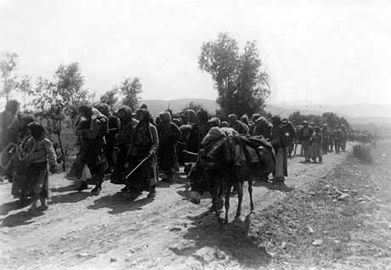Viktor Pietschmann

Viktor Pietschmann (27 October 1881 – 11 November 1956) was an Austrian
His zoological author abbreviation is Pietschmann.[1]
Early life
Viktor Pietschmann was born in Vienna, Austria to parents Karl Pietschmann and Ida in 1881.[2] He graduated in 1899 from the Piaristengymnasium in Vienna and furthered his studies at the University of Vienna in zoology.
Career prior to World War I
In 1905, Pietschmann befriended zoologist
World War I
During World War I, Pietschmann served in the Ottoman Empire from late 1914 to the end of the war.[6] He served the Turkish Army as an officer, providing ski training for a platoon of Turkish and Kurdish soldiers.[5] He then served with the German and Austrian forces and was tasked to make maps of southwest Asia.[6]
Witness to the Armenian genocide
While he was in Erzurum, Pietschmann was witness to the Armenian genocide carried out by the local government authorities.[5] When the Germans and Austrians withdrew their forces from the front, Pietschmann was forced to leave Erzurum on 18 June 1915 by the German consul of Erzurum, Max Erwin von Scheubner-Richter.[7] Pietschmann was accompanied by Carl Schlimme, an assistant of Scheubner-Richter.[7] They were told by the consul to take an Armenian family along and help them find refuge.[5][8] In Bayburt, they were stopped by Turkish soldiers and ordered to surrender the Armenian family.[8] When they refused, the caravan drivers were apprehended. Consequently, Pietschmann and Schlimme were forced to drive the caravans themselves.[8] When Turkish soldiers demanded the Armenian family once more, Pietschmann and Schlimme confronted them with guns and thus secured a passage for themselves out of Bayburt, headed towards Erzincan.[8] Upon arrival in Erzincan, the Armenian family was apprehended and stationed in a local prison under the pretext of concealing weapons in their belongings.[8] According to Schlimme, this was a false accusation since he had searched their belongings for any sort of weapon himself.[8]
During this time, Pietschmann witnessed mass deportations and acts of violence committed against the Armenian deportees.[5][7][9] In his accounts, he indicates that the first wave of deportees were the more prominent members of the local Armenian community.[5] He describes how Armenian deportees were sent further west where they were ultimately killed by being hurled into gorges.[5] This was confirmed by Schlimme's earlier report, in which he described those sent to the Kemah gorge as mostly hungry and half-naked women and children.[8] Schlimme reported that when they gave the deportees some bread, the latter were immediately beaten by the gendarmes for having accepted it.[8] Pietschmann lamented thus over the Armenian children on their way to their destination:[5]
Poor little worms! You have only a few days left, then you will be surrounded by the wet grave of the Kemach gorge. It will end all your fairy-tales, all the beliefs in a beautiful, warm, green, friendly and cheerful world.
Pietschmann and the others reached the port city of Trabzon, where they departed for Constantinople.[10]
Photographs and publications recording the Armenian genocide
Throughout his journey out of Erzurum, Pietschmann took numerous photographs of the deportees along their route. The photos were held in the archives of the Deutsche Bank in Vienna until they were discovered in 2007 by Artem Ohandjanyan, an ethnic Armenian resident of Austria.
Pietschmann published two books about his experiences during the genocide. In his first book, published in 1927 entitled Unter Eis und Palmen (Under Ice and Palms), Pietschmann recalls his travels and writes extensively about the violence suffered by the Armenian deportees.[9] Pietschmann's second publication, entitled Durch kurdische Berge und armenische Städte (Through Kurdish Mountains and Armenian Cities) was published in 1940.[9] It is essentially the diary of his time in the region during that period and is replete with numerous illustrations and photographs.[9]
- Photographs of the deportees by Pietschmann
Return to Austria
After the death of Franz Steindarcher on 10 December 1919, Pietschmann became the curator of the fish collection at the Museum of Natural History in Vienna, a position he held until 1946. During his career, Pietschmann went on a number of trips around the world, including to Hawaii (1927), Anatolia (1931), Poland, and Romania.[2]
He is accredited with discovering the
In 1930, Pietschmann married Margarete August Keldorfer. They had four children.[2]
Viktor Pietschmann joined the Nazi Party in 1932,[15] though little is known about his activities as a member.[9]
Later life
Due to his previous affiliation with the Nazi Party, Pietschmann was forced to retire in 1946. He died on 24 November 1956.[2]
Publications
Some of his publications include:
- Expedition nach Mesopotamien im Jahre 1910. 1911.
- Bandfische und "Grosse Seeschlange". 1922.
- Eis und Palmen – Reiseskizzen aus Nord und Süd. Wilhelm Braumüller Verlag, Wien 1927.
- Durch kurdische Berge und armenische Städte. Adolf Luser Verlag, Wien 1940.
- Führer durch die Sonderschau "Ostmarkdeutsche als Forscher und Sammler in unseren Kolonien": Ein Anteil der Ostmark an der Erforschung und Erschließung der deutschen Kolonialgebiete. Waldheim-Eberle, Wien 1940.
- See also ZOBODAT list of his publications
See also
References
- ^ "Parapercis macrophthalma, Narrow barred grubfish". www.fishbase.ca. Retrieved 2022-09-23.
- ^ a b c d e "Viktor Pietschmann" (PDF). www.landesmuseum.at/ (in German). Naturhistorisches Museum Wien.
- ^ Christa Riedl-Dorn (2001), "Pietschmann, Viktor", Neue Deutsche Biographie (in German), vol. 20, Berlin: Duncker & Humblot, pp. 432–433; (full text online)
- ^ "Viktor Pietschmann (1881–1956)". History of Sciences Natural History Museum.
- ^ ISBN 9780935868913.
- ^ a b c d "New evidence on Armenian Genocide revealed". PanARMENIAN.Net. October 18, 2007.
- ^ ISBN 978-1-903656-81-5.
- ^ ISBN 978-1-78238-143-3.
- ^ ISBN 978-1-4094-9287-0.
- ISBN 3-0340-0561-X.
- ^ "Documents on Armenian Genocide Unearthed". Asbarez. 18 October 2007.
- ^ "ANI Issues Armenian Genocide Poster Exhibit". Genocide Monument. 14 March 2013.
- ^ Pietschmann, V. (1928). "Neue Fischarten aus dem Pazifischen Ozean" [New fish species from the Pacific Ocean]. Anzeiger der Akademie der Wissenschaften in Wien (in German). 65 (27): 297–298.
- ^ Pietschmann, V. (1930). "Remarks on Pacific fishes". Bernice P. Bishop Museum Bulletin. 73: 1–244.
- ISBN 978-3-205-78183-7.






